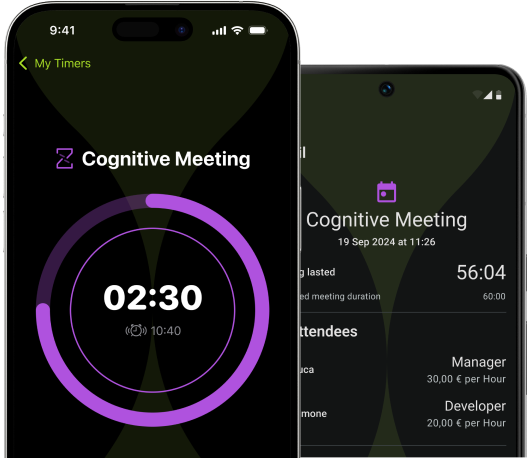Business meetings are essential tools for coordinating teams, making decisions, and moving projects forward. However, if not properly planned, they can become a real waste of time and resources. That is why the importance of clear planning, with a well-structured agenda, cannot be overstated: an effective meeting schedule allows teams to stay focused on goals, optimize time, and engage participants productively.
This article provides you with a step-by-step guide to creating an effective meeting schedule, based on concrete templates and practical tips to avoid common mistakes and improve the efficiency of your business meetings.
Unproductive meetings: how much time is wasted without an agenda?
According to several studies, business meetings take up a significant portion of working time but are often unproductive. A study by Steven Rogelberg of North Carolina University, reported by Harvard Business Review, found that among 182 managers surveyed, 65% said meetings interfere with completing their own tasks, and 71% considered them ineffective and unproductive.
Furthermore, according to recent research reported by Gallup, meetings consume about 15% of a company’s total time. In particular, executives spend two or more days a week in meetings, while considering 67% of them a “failure.” Overall, for U.S. companies, these ineffective meetings represent an annual cost of about $37 billion.
Without a defined agenda, meetings risk dragging on unnecessarily, becoming a missed opportunity and a cost for both the team and the company. Having a clear plan for each meeting is essential to avoid wasting time and to ensure every meeting produces concrete results.
6 practical tips for writing an effective meeting agenda
One of the main keys to ensuring that a meeting is productive is having a well-structured agenda. Here are some practical tips for writing an agenda that helps you optimize time and keep the meeting focused on objectives.
Define clear objectives: what outcome do you want to achieve?
Defining the objectives of a meeting is the first crucial step toward effective planning. Without a clear vision of what you want to achieve, a meeting risks becoming a series of vague discussions without a real purpose. Before creating the agenda, take the time to answer one key question: “Why are we holding this meeting?”
Meeting objectives may vary depending on the type and needs of the business, but they generally fall into a few common categories:
- Decision-making: The goal might be to make an important decision about a project, strategy, or resource. In this case, the agenda should focus on discussing available options and the decision-making process.
- Providing updates: If the purpose of the meeting is to review a project or ongoing activities, the agenda should reflect the points to be updated, leaving space for questions and answers.
- Brainstorming: If the meeting aims to generate creative ideas or solutions to a specific problem, the agenda should encourage collaboration and free idea generation, with a structure that allows participants to express themselves openly.
- Alignment and coordination: If the meeting’s goal is to align the team on a project or company direction, the agenda should focus on synchronizing activities, assigning tasks, and resolving any inconsistencies or difficulties between teams.
Having a clear objective allows you to define precisely the topics to be covered. With well-defined goals, you can also eliminate irrelevant discussions that do not contribute to the final outcome, saving time and increasing productivity.
Select the key points
An overly long agenda can be counterproductive. If the list of topics is too extensive, the meeting risks dragging on, participants may lose focus, and the overall effectiveness of the session decreases. Ideally, you should limit yourself to 6–7 main points, representing the most important themes for achieving the meeting objectives.
Here are some suggestions for selecting the key points:
- Priorities: Choose only topics that are strictly necessary and have the highest impact on the meeting’s objective. Focus on those requiring in-depth discussion or important decisions. Marginal issues should be left aside or handled separately.
- Timing: Consider how much time you have available and distribute it evenly among the selected points. More complex topics may require more time. Avoid overloading the agenda with short updates unless they are crucial.
- Meeting style: Depending on whether it is a strategic, operational, or creative meeting, the agenda will need a different selection of topics. Strategic meetings often require longer discussions on fewer themes, while operational meetings can focus on quick updates and task assignments.
In general, keeping the number of topics limited helps maintain focus and ensures each item receives proper attention. This approach also prevents the common issue of never-ending meetings, where discussions get lost in too many directions.
Specify details for each point
Once the key points are selected, the next step is to detail each agenda item so that all participants can come prepared and clearly understand how to contribute. Detailing each point helps ensure discussions are targeted, time is respected, and everyone knows what is expected of them.
Each agenda point should include:
- Topic: Describe concisely what will be discussed. Avoid vague descriptions. Also specify the type of discussion expected (e.g., update, decision, brainstorming).
- Estimated duration: To prevent meetings from running over or rushing through items, assign a specific duration to each topic.
- Responsible person: Clearly indicate who will lead the discussion for each point. Assigning responsibility gives structure to the meeting and allows participants to prepare better, knowing their role.
Detailing every point not only facilitates participant preparation but also allows the moderator (or meeting leader) to maintain control and ensure all topics are properly addressed.
Order of priorities
When creating the agenda, organize the points in a logical order, based on their importance and urgency. The order in which topics are addressed can significantly affect the meeting’s productivity.
- Start with the main topics: The first points should be the most important or urgent. Addressing strategic or high-attention topics first ensures they are covered while participants are most focused.
- Less urgent items at the end: Leave less critical topics or short updates for the end. If time runs short, it is easier to postpone them.
Flexibility
Even with a detailed and structured agenda, flexibility is crucial for a successful meeting. Business meetings can be unpredictable, and discussions may take longer than expected. The ability to adapt in real time without losing overall focus is important.
- Allow time margins: Add extra time for each point to manage unexpected longer discussions.
- Be ready to modify the agenda: Sometimes a seemingly minor issue may turn out to be significant. Recognizing when to adjust is a sign of good leadership.
- Manage time dynamically: If a topic cannot be addressed adequately, define immediate next steps and schedule a follow-up instead of leaving it unresolved.
Use clear and direct language
An unwritten rule for making an agenda accessible to everyone is to use clear and straightforward language. Avoid jargon or overly complex terms that may confuse participants. Simplicity makes the agenda easier to understand and keeps participants focused.
Common mistakes to avoid
Even when preparing an agenda, there are some common mistakes that can compromise a meeting’s effectiveness. Here are the most frequent ones to avoid:
Too many points to cover
Including too many items can dilute the quality of the discussion. It’s better to focus on 4–6 key topics, allowing enough time for each.
Unrealistic timing
Failing to plan realistic times for each point is a common mistake. Assign adequate durations and always include extra time for unforeseen needs.
Not involving the right participants
Ensure that participants are relevant to the topics. If someone is not directly involved, their presence may cause distractions and reduce effectiveness.
Ignoring the follow-up
A good agenda does not end with the meeting. It must include a follow-up plan: assign responsibilities, set deadlines, and review progress. Always conclude with a summary of next steps.
Agenda templates for different types of meetings
Each type of meeting has different characteristics and objectives. Here are some sample agenda templates for various business meetings:
Informational Meeting
- Goal: Provide updates on projects, company changes, or new developments.
- Key points: Updates on ongoing projects, policy changes, product launch updates.
- Estimated time: 1 hour
- Sample agenda:
- 15 min: Project updates (Owner: Marco)
- 15 min: Policy changes (Owner: Laura)
- 15 min: New product/service launch details (Owner: Sara)
- 15 min: Q&A (Owner: All)
Brainstorming Meeting
- Goal: Generate creative ideas and innovative solutions.
- Key points: Define the problem, generate ideas, analyze best proposals.
- Estimated time: 1–2 hours
- Sample agenda:
- 20 min: Problem introduction (Owner: Francesco)
- 40 min: Open brainstorming (Owner: All)
- 30 min: Analysis of best ideas (Owner: Laura)
- 20 min: Summary of solutions and task assignment (Owner: Giovanni)
Decision-Making Meeting
- Goal: Make strategic decisions about budget, projects, or company choices.
- Key points: Present options, discuss implications, make final decision.
- Estimated time: 1–1.5 hours
- Sample agenda:
- 30 min: Present available options (Owner: Marco)
- 30 min: Discussion and evaluation (Owner: Laura)
- 20 min: Final decision (Owner: Giovanni)
- 10 min: Action planning and task assignment (Owner: Anna)
Adapting the agenda to different business needs
Remember that adapting the agenda to your company’s specific needs and the type of meeting is essential. To summarize:
- Meeting type: Every meeting has a different goal. A brainstorming session requires different management than an operational or strategic meeting.
- Useful tools: Use project management tools such as Trello, Asana, or Slack to prepare and share the agenda. Shared calendars, such as Google Calendar, are also useful to send agendas in advance.
- Flexibility: The agenda must remain flexible. If new points emerge during the meeting, they can be added—but always keeping focus on the main themes.
In conclusion, good planning is the foundation of an effective meeting. By following practical advice and using concrete templates to create well-structured agendas, you can reduce wasted time and improve the overall efficiency of your business meetings. A well-managed meeting not only optimizes time but also helps achieve tangible results.
Start applying these tips to your meetings today and see how they improve your schedules and overall productivity. Don’t forget to ask participants for feedback to improve future agendas!




